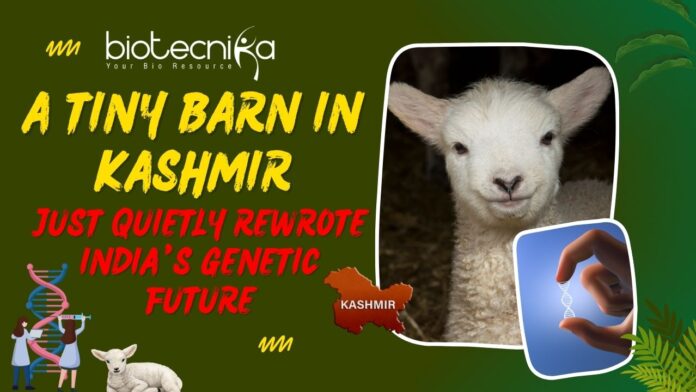India’s First Gene-Edited Sheep Using CRISPR Technology at SKUAST-Kashmir
In a place usually known for conflicts, Kashmir has quietly made a significant scientific breakthrough. Instead of focusing on border tensions, this time the news is about a genetic achievement. Scientists at Sher-e-Kashmir University of Agricultural Sciences and Technology (SKUAST-Kashmir) have created India’s first gene-edited sheep using CRISPR technology.
A lamb was born with 30% more muscle, not through mixing breeds or adding foreign DNA, but by precisely editing its genes. In a region often marked by unrest, this discovery brings a new kind of strength, one powered by science, not conflict.
The ‘Lamb of the Future’ Is Born
Inside a secure lab, researchers at SKUAST-Kashmir used the powerful CRISPR-Cas9 gene-editing tool to create India’s most advanced sheep. They edited a specific gene called myostatin, which normally limits muscle growth. The result? A lamb with 30% more muscle than an average Indian sheep. Think of it as a naturally strong sheep, just fluffier and on four legs.
But this breakthrough is not just about making stronger animals. It’s about using precise science to improve animal health and farming. Unlike traditional crossbreeding, which takes years and mixes in unwanted traits, CRISPR allows for quick, clean, and accurate changes to an animal’s own DNA.
From Crossbreeding to Precise Gene Editing
India has long used crossbreeding to improve livestock, mixing different breeds to get better meat or wool. But this method is slow and uncertain. Now, scientists can directly edit genes instead of waiting generations for results.
This is not about adding foreign genes. It’s just carefully adjusting the animal’s own DNA. For example, the new lamb from SKUAST has more muscle thanks to a natural change seen in some European sheep. It’s Indian science helping Indian animals catch up to global standards, faster and more precisely.
The Brains Behind the Breakthrough
The old players of the game, Dr. Riyaz A. Shah and his team, have led this genetic revolution. They have already shocked the world by cloning India’s first Pashmina goat, Noori. This innovation has gained global attention. This time, with the power of CRISPR, they are chasing a bigger dream. They are building India’s most advanced reproductive biotechnology lab.
Prof. Nazir Ahmad Ganai, Vice Chancellor, is the mastermind behind SKUAST’s transformation into a biotech powerhouse. This visionary man declared that this is not just the birth of a lamb. It is the birth of a new era. Strong words, but well-earned.
Why is CRISPR special?
CRISPR-Cas9, often known as the “genetic scissors,” is not just another scientific tool. It is one of the most precise and powerful tools of modern biology. Finally, India is utilizing this genetic superpower like never before.
This advanced tool allows researchers to modify the genetic material. By cutting out unwanted traits and boosting useful ones, researchers are rewriting the DNA. Currently, they are working on muscle growth, disease resistance, and milk production genes. Because no foreign genes are added, this method often avoids the political and ethical issues linked to GMOs.
In layman’s language, this lamb is not a “genetically modified animal, but a genetically upgraded one.”
Science and Safety
The SKUAST team has followed global safety protocols. The lab is not transgenic and does not contain any foreign genetic material, which is a huge deal. In India, transgenic animals are still under the regulatory process. But gene editing makes the process cleaner, safer, and more acceptable to the public and policymakers. It is the biotech version of going organic, but with microscopes and molecular maps.
New Era of Indian Agriculture
Another Indian milestone was recently unveiled by the Union Agriculture Minister, the country’s first gene-edited rice variety. With these innovations, the Indian genetic game is leveling up. It no longer belongs in labs, but now in fields, farms, and livestock sheds. This transformation can help India trackel food security, livestock productivity, and rural incomes. Imagine a sheep that grows faster, is disease resistant, and produces better meat, all without importing any foreign breeds. The gene revolution is not coming. It has already arrived, and Kashmir has embraced it.
Kashmir’s Silent Science Revolution
The scientists at SKUAST-Kashmir are not stopping with just one breakthrough. The researchers are currently working on vaccines, gene therapy, cloning, and stem cells. While the world debates the ethics of AI and biotechnology, the team here is focused on real progress, one discovery at a time.
Recently, Prof. Ganai has shared this success story with Lieutenant Governor Manoj Sinha, who has praised this milestone. He said that it’s not just about science. The world will now know Jammu and Kashmir as a center of innovation and growth.
Global Attention on a Local Lab
As countries compete in biotechnology, SKUAST’s achievement puts India on the world map, not as a follower, but as a quiet leader.
Some people have concerns, especially about ethics. But gene-edited animals are less controversial than GMOs. There’s no “franken-sheep” here. It’s just science speeding up what nature already does.
With the year full of chaos, controversies, and countless stories, the birth of this gene-edited lamb has changed the future of Kashmir. It is a genetic landmark. A subtle but seismic shift in how we look at framing, food, and the future.
It’s not a sci-fi movie, but today’s reality. In the story of indian science, this little lamb is becoming a legend. So, next time you hear a sheep bleat, remember that in a quiet barn in Kashmir, this sound is rewriting the future of science.























